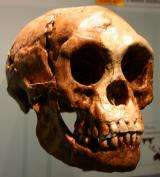Homo floresiensis (the "Hobbit"). Image: Ryan Somma, Wikimedia Commons.
A trio of researchers studying the skull bones of Homo floresiensis has determined that its face was likely much closer to that of humans than apes. In their paper published in the Journal of Archeological Science, the team describes the techniques they used to determine what the face of the ancient hominin would most likely have looked like based on archeological evidence.
Homo floresiensis—nick-named the "hobbit" after the little people in the Lord of the Rings trilogy—was first discovered in 2003 by a team led by Professor Mike Morwood (who passed away just yesterday) in a cave on the island of Flores, Indonesia. At just three feet tall, the remains of the little people have left researchers scratching their heads trying to categorize them. Like other difficult-to-classify hominins, the hobbit people vanished after existing for a period of time—in their case, approximately 12,000 years ago. In this new effort, three members of the team that originally discovered Homo floresiensis (including Morwood) sought to settle the dispute regarding what their faces looked like.
The trio note that the hobbit people clearly did not resemble apes, or more specifically chimps—they clearly had cheeks—chimps do not. Next, after careful analysis of the single whole skull that was recovered on Flores they verified the relationship between bone and soft tissue, comparing them with human samples. This allowed them to draw a face which was subsequently compared to nine other faces that have been generated from prior research of other hominins of roughly the same era, using geometric morphometrics. That led to further refinements of the face of the hobbit, which the team reports, looks reasonably similar to modern humans.
In conclusion, the team suggests that earlier efforts by others to create drawings of the hobbits' face were inaccurate likely due to misplaced assumptions about the nature of the little people. Some had suggested, they note, that the little hominins were wild creatures or were the missing link between modern humans and apes. The new drawings support theories that suggest Homo floresiensis was more likely a descendant of Homo erectus.
More information: Journal of Archeological Science DOI: 10.1016/j.jas.2013.06.028
Journal information: Journal of Archeological Science
© 2013 Phys.org























